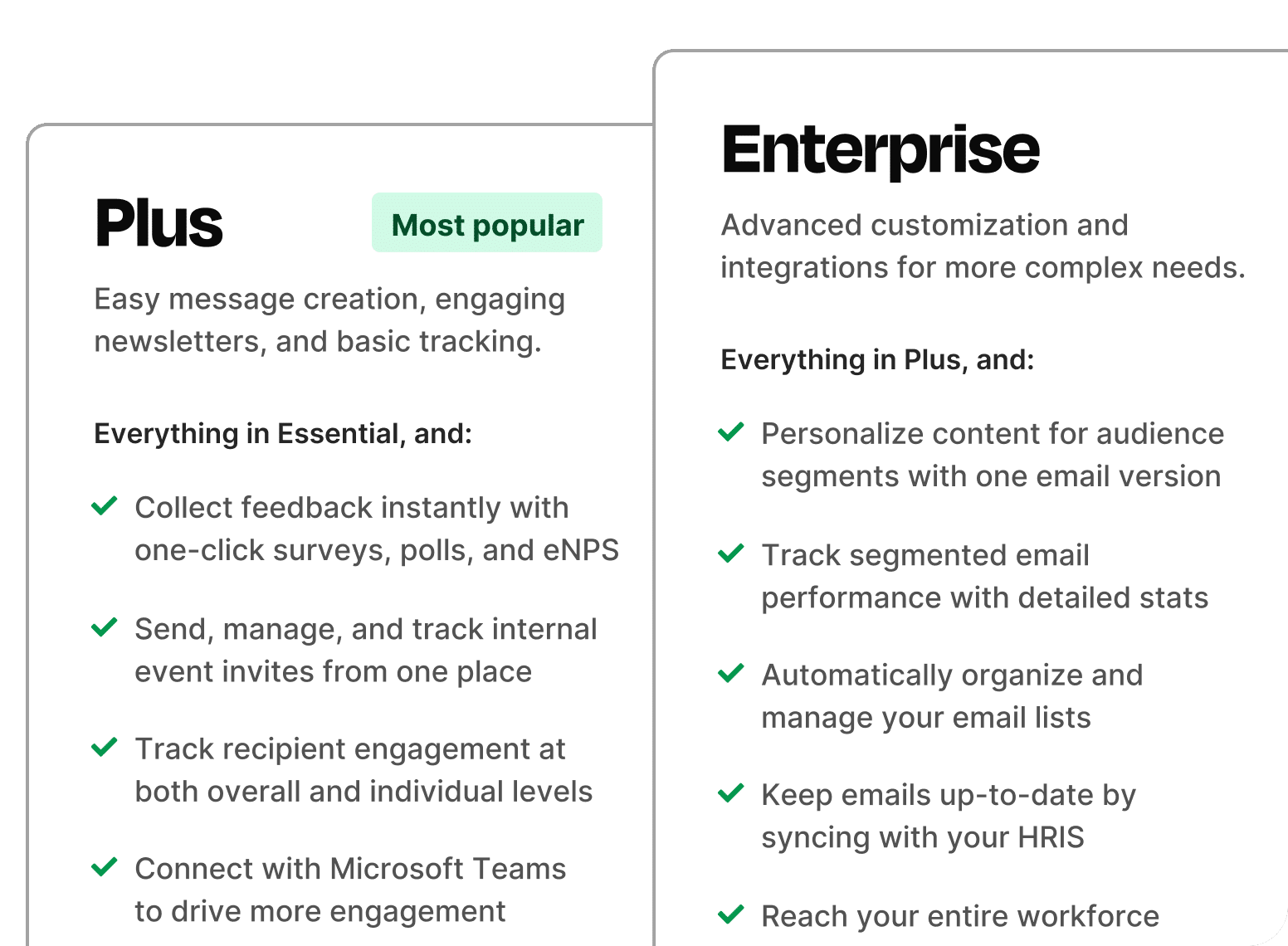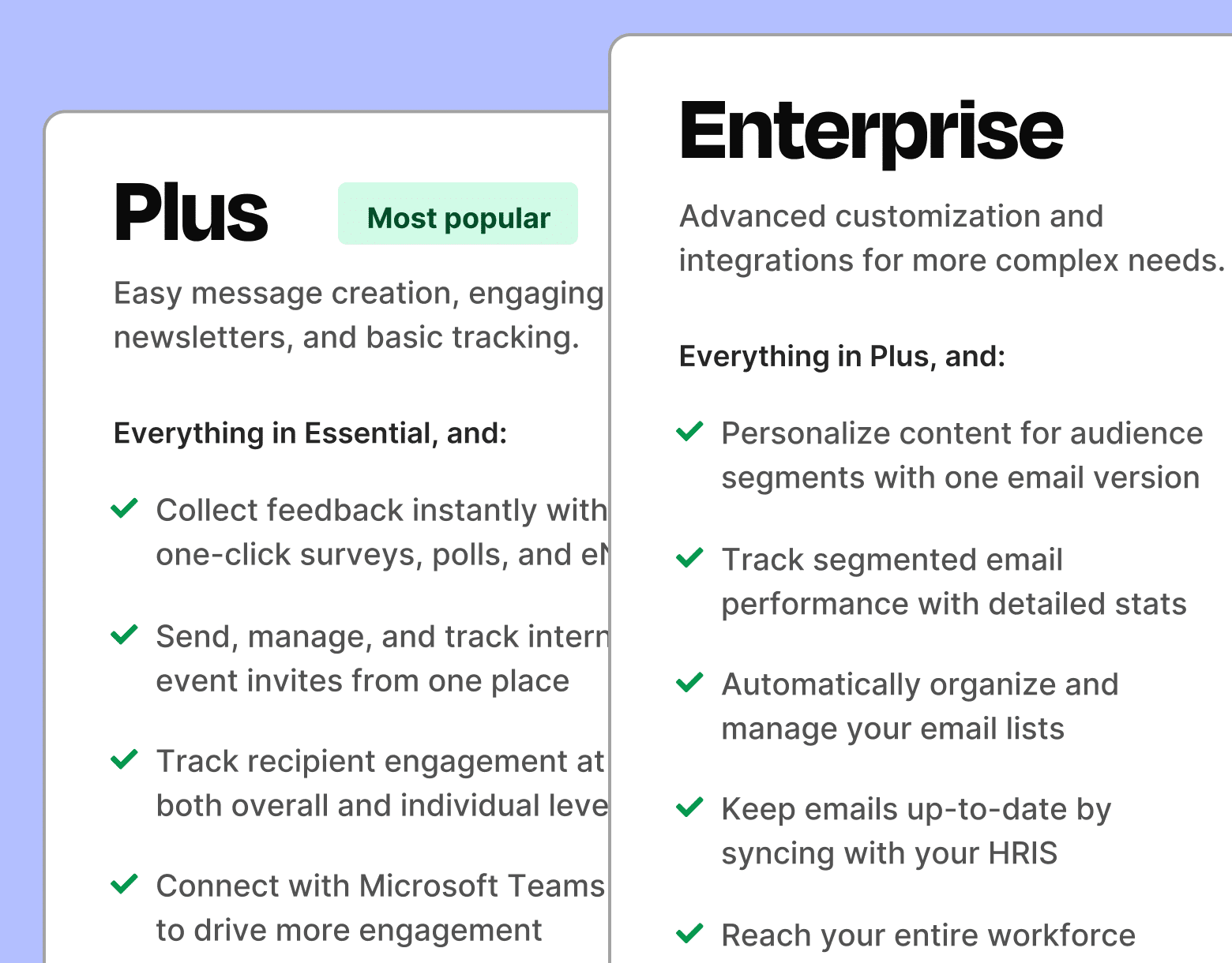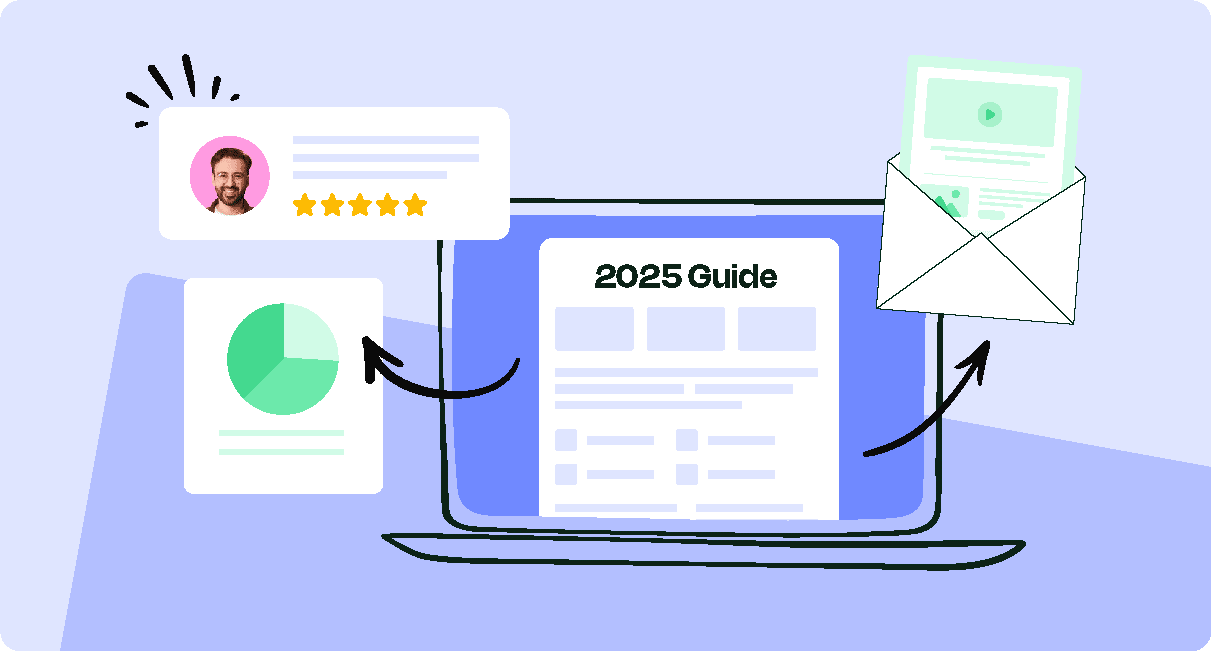With the right internal communications calendar, you can manage a schedule that aligns company-wide objectives with employees’ attention spans. Read on as we share how to create a balanced internal comms calendar that hits every note.
You’re about to press “send” on your monthly HR memo when—ping!—your CEO’s leadership update goes live on the intranet. Meanwhile, the marketing team just teased a product launch announcement, and IT has sent a system maintenance reminder.
If this sounds familiar, you’re not alone. At countless organizations, employee inboxes have become a free-for-all for cross-departmental updates. However, as internal communications pros or HR leaders, you’ve been tasked with engaging employees. And this starts (and stops) with a coordinated internal communications content calendar.
In this post, we’ll explore exactly how to build, maintain, and leverage an internal comms content calendar that balances consistency with realistic ad hoc flexibility.
Find out how ContactMonkey’s internal communication solutions can help you create and manage your content calendar.
Take a self-guided tour of ContactMonkey
See how our key features can streamline your internal communications.
Take product tour

What Is An Internal Communications Content Calendar?
An internal communications content calendar is your organization’s blueprint for delivering timely, relevant messages to employees. Your calendar should include various types of content to support leadership and each department, plus build a thriving culture.
Think of your internal communications content calendar as an editorial roadmap. This internal comms calendar should include what needs to be communicated, who should receive the message, when it should be sent, and how it will be distributed (e.g. email, intranet, chat, etc.).
Unlike a traditional editorial calendar used in marketing, an internal comms content calendar focuses exclusively on employee-facing messages and aligns with your overall internal communication strategy.
Why Your Company Needs an Internal Comms Calendar
An internal communications content calendar helps you space things out so no important update gets lost in the shuffle. Here are the main reasons why your company needs an internal communication strategy and calendar:
- Centralized messaging: An internal communications content calendar gives you one source of truth for all employee messages, preventing overlap and confusion.
- Reduced overwhelm: When you map out every memo on an internal comms calendar, you space out announcements so employees aren’t bombarded with too many updates at once.
- Aligned departments: A shared internal comms calendar template ensures teams know when others are sending out announcements, minimizing accidental conflicts or duplicate messaging.
- Consistency and trust: When employees see that important news always arrives through a structured, predictable internal communications calendar, engagement and trust naturally increase.
- Strategic storytelling: A well-planned internal communications calendar template allows you to weave company goals, values, and milestones into your messaging—helping employees see the bigger picture.
- Performance insights: An internal comms content calendar makes it easier to track employee engagement metrics, and then refine your internal communication strategy as needed.
Modern internal comms and measurement tools
No design or technical expertise needed. Save time, increase engagement, and dazzle your employees with fun and interactive communications.
Explore all features

How to Create Your Internal Communications Content Calendar
Below, we’ll guide you through the essential steps to build a content calendar that drives alignment with your strategic goals, strengthens cross-team collaboration, and keeps employees genuinely engaged.
1. Define your internal communication strategy and objectives
Clarify what you want to achieve with your internal comms content calendar—whether it’s boosting engagement, unifying messaging, or fostering transparency. Know which types of employee content drive the most engagement and establish key themes to provide a cohesive storyline that underpins all your communications.
Why this matters: Without clear objectives and key themes, messages can feel random or disconnected. A strong foundation keeps your internal communications calendar organized and relevant to broader company goals.
Practical examples:
- If your objective is to enhance wellness awareness, schedule a “Wellness Wednesday” update each week.
- To boost recognition, plan monthly spotlights on standout employees. For more on this front, check out these employee recognition ideas.
How to execute:
- Brainstorm with department heads to identify recurring topics (e.g., policy updates, leadership briefings, HR initiatives).
- Prioritize themes based on employee needs and organizational milestones (e.g., quarterly goals, event dates).
Considerations:
- Ensure your themes support your internal communication strategy and align with company culture.
- Be ready to pivot if business goals or employee feedback shifts.
PRO TIP: Use ContactMonkey’s segmentation features to tailor emails around specific themes. This helps create targeted communications that resonate with different employee groups—all synced to your overarching objectives.
2. Audit existing internal communication channels
Before populating your internal communications content calendar, conduct an internal communications audit and examine current messaging to see what’s working and what’s not. Identify redundancies, gaps, and opportunities for more effective engagement.
Why this matters: An audit helps you avoid message overload and ensures each communication has a clear purpose. It also highlights which internal communication channels get the best results.
Practical examples:
- List every recurring update, from weekly newsletters to IT maintenance alerts.
- Note which announcements garner high open rates or strong employee feedback.
How to execute:
- Gather data on engagement (opens, clicks, responses).
- Interview or survey departments to find out how often they send messages.
- Evaluate content overlap: Are multiple teams sending similar updates?
Considerations:
- Look for underused internal communication platforms that could be more effective.
- Be mindful of timing—avoid peak busy periods to mitigate message fatigue.
PRO TIP: Leverage ContactMonkey’s analytics features to pinpoint which emails or newsletters resonate most. Use this insight to refine your internal comms calendar so every message contributes to your overall internal communication strategies.
3. Select the tools you need to execute your internal comms calendar
Decide if your internal communications calendar template will live in a spreadsheet, a project management tool, or specialized internal communication software. The right format should be accessible, easy to update, and transparent across teams.
Why this matters: Having a centralized system streamlines planning and ensures no crucial announcements slip through the cracks.
Practical examples:
- A Google Sheet with color-coded columns for dates, topics, channels, and owners.
- A Trello or Asana board that visually tracks message progress from “Draft” to “Sent.”
How to execute:
- Assess your organization’s existing internal communication tools (e.g., SharePoint, collaboration software).
- Choose a format that suits both your team’s workflow and complexity needs.
Considerations:
- Make sure your calendar can be shared organization-wide (or at least with key stakeholders).
- Integrate with email platforms or intranets for seamless scheduling.
PRO TIP: Sync your sending plan with your internal communications calendar for real-time coordination, thanks to integrations that let you schedule internal comms without juggling multiple apps.
4. Map out your internal communications content calendar timeline
Plot recurring updates and special events on your internal comms calendar in a way that ensures messages won’t overlap or overwhelm employees. This includes big-ticket items like monthly newsletters, leadership updates, and seasonal campaigns.
Why this matters: A well-structured timeline prevents conflicting communications and delivers a steady cadence of information, keeping employees engaged without overloading them.
Practical examples:
- If your CEO hosts a quarterly town hall, list it months ahead to schedule lead-up announcements.
- For an upcoming product launch, include teaser messages and final reminders leading up to the reveal.
How to execute:
- Start with fixed dates (e.g., end-of-quarter finances, annual performance reviews).
- Fill in your internal comms content calendar with flexible dates for newsletters, milestones, or ad-hoc announcements.
Considerations:
- Account for busy periods like holidays, fiscal year-end, or major company events.
- Keep buffer slots for last-minute changes or crisis communications.
PRO TIP: Use ContactMonkey’s scheduling feature to plan emails that align with your mapped-out timeline. You can draft months ahead, set precise send dates, and deliver messages at optimal times.
Watch ContactMonkey LIVE in action
Join live demo

5. Assign responsibilities and deadlines to your internal comms calendar
Clarify who’s drafting, reviewing, and distributing each message on your internal comms content calendar. Establish firm timelines so stakeholders know their roles and deliverables.
Why this matters: Clear ownership and deadlines prevent last-minute scrambles and ensure high-quality, on-brand communications.
Practical examples:
- HR writes the content for the bi-weekly benefits update; the Communications Manager reviews it two days before sending.
- The IT lead drafts system maintenance notices, which must be approved by the CTO before distribution.
How to execute:
- Create a chart listing each piece of communication, the person responsible, and the review process.
- Set reminders or calendar invites to nudge team members before their deadlines.
Considerations:
- Plan backups if primary content owners are on leave.
- Ensure each piece of communication follows brand and compliance guidelines.
PRO TIP: ContactMonkey’s approval workflows let you build in sign-off stages directly within Outlook or Gmail. This keeps content reviews organized and on time—no email chain confusion required.
6. Integrate feedback and analytics to improve internal comms calendar planning
Use data from internal communication examples—like open rates, click-throughs, or quick pulse surveys—to see what resonates with employees. Then, adjust your internal comms calendar template to focus on proven messaging strategies.
Why this matters: Data-driven insights help you fine-tune timing, subject lines, and content, ensuring your internal communications content calendar is always improving.
Practical examples:
- If open rates for Friday emails are low, switch them to Wednesday and compare results.
- Embed short polls in newsletters to gauge understanding of new policies.
How to execute:
- Track performance metrics after each send.
- Hold periodic review meetings to discuss analytics and identify areas for optimization.
Considerations:
- Factor in different time zones or shift schedules if you have a dispersed workforce.
- Continually revisit which internal communication channels or platforms yield the best engagement.
7. Align your internal comms calendar with the broader company’s
Cross-reference your internal comms calendar with other organizational calendars—like marketing, product, and event calendars—to ensure alignment and avoid overlap.
Why this matters: Coordinated messaging reinforces business priorities and creates a more consistent employee experience across departments.
Practical examples:
- Sync internal updates with product launches to share behind-the-scenes insights or employee contributions.
- Align culture campaigns with external awareness events (e.g. Mental Health Week or International Women’s Day).
How to execute:
- Meet quarterly with stakeholders across departments to share upcoming initiatives.
- Add key milestones and cross-functional events to your internal communications content calendar.
Considerations:
- Be mindful of conflicting timelines and adjust messaging cadence when necessary.
- Maintain clear ownership over who communicates what and when.
Take a self-guided tour of ContactMonkey
See how our key features can streamline your internal communications.
Take product tour

8. Build employee recognition into internal communication strategy
Include recurring moments in your calendar to celebrate employees, teams, and wins—big or small—to boost morale and promote a culture of appreciation.
Why this matters: Recognition is one of the most powerful drivers of engagement, and planning it in advance ensures it’s consistent and meaningful.
Practical examples:
- Add birthdays, anniversaries, or new hire shoutouts to your monthly newsletters.
- Highlight team wins in a “Friday wrap-up” email with interactive polls or reactions.
How to execute:
- Create a repeating event in your calendar for recognition touchpoints.
- Collect data from managers or your HR system to automate celebratory content.
Considerations:
- Ensure celebrations are inclusive and relevant across departments, roles, and locations.
- Be intentional about tone—genuine appreciation goes a long way.
PRO TIP: With ContactMonkey’s personalization features, you can automate recognition emails using merge tags—making shoutouts feel personal without the manual effort. Learn how to send personalized email by following our article to access more insight on this topic.
9. Use internal comms calendar insights to forecast future needs
Review past calendar performance to identify trends and inform future planning. Use what worked (and what didn’t) to shape smarter communication strategies moving forward.
Why this matters: Looking ahead based on historical insights helps you stay proactive, avoid burnout during peak periods, and improve your content’s relevance.
Practical examples:
- If employee engagement drops during summer months, shift to lighter content or reduce frequency.
- Plan quarterly CEO messages around key reporting or goal-setting milestones.
How to execute:
- Analyze calendar engagement data quarterly to identify patterns in timing, frequency, and content types.
- Use these insights to plan campaigns around high-engagement windows and avoid low-response periods.
Considerations:
- Account for seasonal slowdowns, company goals, and shifting employee preferences.
- Adjust not just timing, but also tone, format, and channel usage based on results.


10. Refine and optimize your internal communications calendar
Your internal communications content calendar is a living document. Schedule regular check-ins to revisit objectives, evaluate performance, and make necessary tweaks.
Why this matters: Employee needs and business goals evolve. Staying flexible helps you stay ahead of shifting priorities while keeping your communications relevant.
Practical examples:
- Conduct a quarterly “calendar audit” meeting with department heads to swap outdated themes or campaigns.
- Adjust frequency if employees show signs of email fatigue.
How to execute:
- Compare actual outcomes (e.g., engagement rates) against your defined goals.
- Incorporate feedback from employees—what would they like to see more or less of?
Considerations:
- Keep some open slots for unexpected announcements or pivots in your strategy.
- Stay updated on new internal communication software or platforms that could streamline your process further.
PRO TIP: Use ContactMonkey’s pulse surveys to gauge employee sentiment on a regular basis. Use the data to steer future messaging, ensuring your internal comms calendar continuously reflects your workforce’s evolving interests. Plus, if you’re struggling to get quality feedback, this article explains how to improve employee feedback.
How to Use Your Internal Comms Content Calendar for Internal Communications
Once your internal communications content calendar is in place, the real magic happens in how you use it to keep employees engaged. Below are practical strategies to help you get the most out of your newly crafted calendar:
- Centralize and reference it often: Treat your internal comms calendar as the single source of truth for all employee-facing announcements. Store it in a shared drive or platform where all stakeholders can access and update it in real-time.
- Coordinate across departments: Work cross-functionally with team leads, department heads, and HR to populate the calendar collectively. This approach not only streamlines your workflow but also ensures consistency across all organizational messaging.
- Vary your communication channels: Meet employees where they are—email, chat platforms, intranet posts, or even digital signage. Diversifying your channels maintains fresh engagement and respects different work styles.
- Build campaigns around key initiatives: Plan themed blocks in your calendar, like “Wellness Month” or “Innovation Week,” and cluster-related updates which are prime internal communication campaign examples. This creates a cohesive, narrative-driven approach to important topics.
- Stay flexible for unexpected changes: Block off “buffer zones” for crisis communications or urgent leadership directives. Having dedicated space for the unplanned keeps your calendar nimble and your core messages intact.
BONUS: Knowing channel diversification is a key component to a successful IC program, do you have a channel matrix developed? If not, use our guide on how to create an internal communication channel matrix!
Key Signs You Need a Modern Internal Comms Tool
If important updates are getting buried in a flood of messages, it’s time to rethink your approach. Limited engagement metrics, inconsistent branding, and manual processes are all signs your current setup is holding you back. As your workforce grows or becomes more hybrid, siloed teams increase the risk of conflicting messages. A modern internal comms tool can help you streamline, align, and engage—without the chaos.
How ContactMonkey can support your practice:
- Automation: Frees you from repetitive tasks.
- Centralized scheduling: Ensures clarity across departments.
- Real-time analytics: Tracks performance for data-driven decisions.
- Template consistency: Standardizes your brand voice.
- Targeted messaging: Reaches the right employees at the right time.
When low engagement, scattered messaging, and manual tasks become daily headaches, you’re overdue for an advanced internal comms tool. Boo



